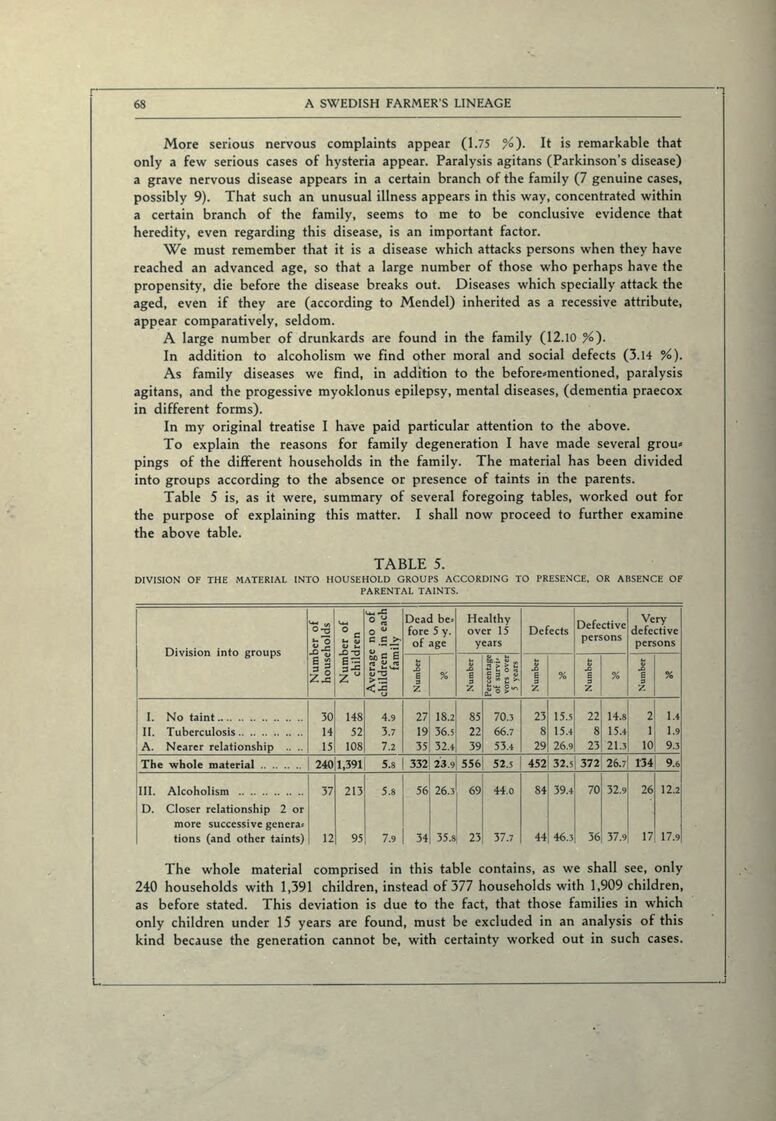
Full resolution (JPEG) - On this page / på denna sida - Part I - Professor Herman Lundborg, Uppsala, The History of a Swedish Farmer’s Lineage as seen from a Race-biological Stand-point

<< prev. page << föreg. sida << >> nästa sida >> next page >>
Below is the raw OCR text
from the above scanned image.
Do you see an error? Proofread the page now!
Här nedan syns maskintolkade texten från faksimilbilden ovan.
Ser du något fel? Korrekturläs sidan nu!
This page has never been proofread. / Denna sida har aldrig korrekturlästs.
More serious nervous complaints appear (1.75 %). It is remarkable that
only a few serious cases of hysteria appear. Paralysis agitans (Parkinson’s disease)
a grave nervous disease appears in a certain branch of the family (7 genuine cases,
possibly 9). That such an unusual illness appears in this way, concentrated within
a certain branch of the family, seems to me to be condusive evidence that
heredity, even regarding this disease, is an important factor.
We must remember that it is a disease which attacks persons when they have
reached an advanced age, so that a large number of those who perhaps have the
propensity, die before the disease breaks out. Diseases which specially attack the
aged, even if they are (according to Mendel) inherited as a recessive attribute,
appear comparatively, seldom.
A large number of drunkards are found in the family (12.10 %).
In addition to alcoholism we find other moral and social defects (3.14 %).
As family diseases we find, in addition to the before=mentioned, paralysis
agitans, and the progessive myoklonus epilepsy, mental diseases, (dementia praecox
in different forms).
In my original treatise I have paid particular attention to the above.
To explain the reasons for family degeneration I have made several grou*
pings of the different households in the family. The material has been divided
into groups according to the absence or presence of taints in the parents.
Table 5 is, as it were, summary of several foregoing tables, worked out for
the purpose of explaining this matter. I shall now proceed to further examine
the above table.
TABLE 5.
DIVISION OF THE MATERIAL INTO HOUSEHOLD GROUPS ACCORDING TO PRESENCE. OR ABSENCE OF
PARENTAL TAINTS.
Division into groups ’"S ^ °2 u o Number of children Average no of children in each family Dead be» fore 5 y. of age Healthy over 15 years Defects Defective persons Very defective persons
E 2 £ ° Z jc Number % Number Percentage of survi» | vors over 5 years | Number % Number % Number 1 %
I. No taint 30 148 4.9 27 18.2 85 70.3 23 15.5 22 14.8 2 1.4
II. Tuberculosis 14 52 3.7 19 36.5 22 66.7 8 15.4 8 15.4 1 1.9
A. Nearer relationship .. .. 15 108 7.2 35 32.4 39 53.4 29 26.9 23 21.3 10 9.3
The whole material 240 1,391 5.8 332 23.9 556 52.5 452 32.5 372 26.7 134 9.6
III. Alcoholism 37 213 5.8 56 26.3 69 44.0 84 39.4 70 32.9 26 12.2
D. Closer relationship 2 or
more successive genera? tions (and other taints) 12 95 7.9 34 35.8 23 37.7 44 46.3 36 37.9 17 17.9
The whole material comprised in this table contains, as we shall see, only
240 households with 1,391 children, instead of 377 households with 1,909 children,
as before stated. This deviation is due to the faet, that those families in which
only children under 15 years are found, must be exeluded in an analysis of this
kind because the generation cannot be, with certainty worked out in such cases.
t_
<< prev. page << föreg. sida << >> nästa sida >> next page >>